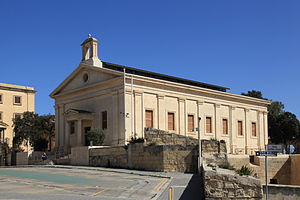|
Malta Stock ExchangeThe Malta Stock Exchange (Maltese: Borża ta' Malta), known as the Borża ta' Malta, is the stock exchange of the island nation of Malta. Since being set up in 1992, the Exchange has been key to the raising of capital for the private sector through the issue of corporate bonds and equity while virtually all the national debt of Government of Malta has been issued in the form of Malta Government bonds and treasury bills that are listed and traded on the secondary market. 35°53′42″N 14°30′42″E / 35.89500°N 14.51167°E
The investor base consists of over 75,000 individual investors, which is a significant number given Malta's economic size (GDP €8,796 million in 2015) and population (434,403 in 2016). The focus of the Malta Stock Exchange is to continue to develop and support the domestic market whilst attracting international companies to list on the Exchange, and enjoy the passportability within the EU that this brings. It has also invested heavily in the use of technology and uses the Xetra trading platform. The chairman of the board of the Malta Stock Exchange is Joseph Portelli, and the chief executive officer is Simon Zammit. On 23 August 2023, the company formed EuroCTP as a joint venture with 13 other bourses, in an effort to provide a consolidated tape for the European Union, as part of the Capital Markets Union proposed by the European Commission. History The Exchange was established with the enactment of the Malta Stock Exchange Act in 1990, and commenced trading operations on 8 January 1992.[1] The Central Bank of Malta was originally appointed as the supervisor of the Exchange,[2] a role now assumed by the Malta Financial Services Authority (MFSA). In 1999, the Exchange moved into the former Garrison Chapel building in Castille Square, Valletta. This iconic building was built in 1857 on the designs of T. M. Ellis, and was used as a multi-denominational place of worship until 1950. The former church was then used for entertainment purposes, as a post office and as a naval school, before it was taken over and extensively renovated by the Exchange. It has been known since then as the Exchange Building or The Borsa.[3] The Exchange is located close to the Office of the Prime Minister at Auberge de Castille and the Upper Barrakka Gardens.[4][5] In 2013, the Exchange achieved Designated Offshore Securities Market status by the U.S. Securities and Exchange Commission complementing the HM Revenue and Customs recognition that had been obtained from the UK authorities in 2005. Services The Malta Stock Exchange offers the following services:
The Malta Stock Exchange is Malta's national numbering agency, issuing ISINs in respect of all securities issued in Malta. MembershipThe MSE is a member of:
See alsoFurther reading
ReferencesWikimedia Commons has media related to Malta Stock Exchange.
External links |
||||||||||||||||||


